Introduction to Bergen-Belsen"In our collective conscience, we have to remember the lessons to be learnt from these events: to ensure that never again should the mass murder of millions of people be possible as it occurred in Auschwitz, in Bergen-Belsen; the genocide of the Jews, the gypsies, in order to ensure that events like these can never be repeated we have to understand why they could happen. We must not forget." Simone Veil, an inmate at Bergen-Belsen from January 1945 to April 15, 1945 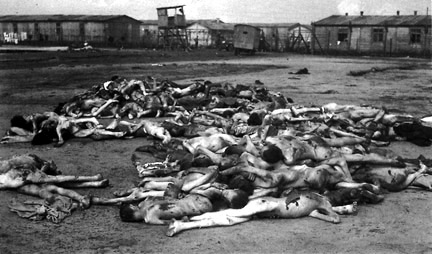 Bergen-Belsen was the name of an infamous Nazi camp which has become a symbol of the Holocaust that claimed the lives of 6 million Jews in Europe more than sixty years ago. In 1943, Bergen-Belsen was initially set up as a detention camp (Aufenthaltslager) for prisoners who held foreign passports and were thus eligible to be traded for German citizens being held in Allied internment camps. In December 1944, Bergen-Belsen became a concentration camp under the command of Josef Kramer, the former Commandant of the Auschwitz II camp, also known as Birkenau. A section for sick prisoners, who could no longer work in the Nazi forced labor camps, was set aside at Bergen-Belsen in March 1944. In 1945, when World War II was drawing to a close, civilian prisoners were evacuated from other concentration camps as Soviet troops advanced westward; thousands of these prisoners were brought to the Bergen-Belsen camp which was not equipped to handle such a large number of people. Finally, Bergen-Belsen itself was right in the middle of the war zone where bombs were falling and Allied planes were strafing the Autobahn and the railroads. British and Germans troops were doing battle on the Lüneberg heath right outside the camp. In February 1945, the situation at Bergen-Belsen became catastrophic when a typhus epidemic broke out in the crowded camp.  By April 1945, the war in Europe was very definitely over. All that was needed now was a formal surrender signed by Adolf Hitler. Hitler was a broken man: his dream of uniting the German folk into a Thousand Year Reich was gone, his health was ruined by Parkinson's disease and for the past several years, his mental capacity had been increasingly failing. He was holed up in an underground bunker beneath his Chancellery in Berlin, still moving his armies around on a map and unwilling to admit defeat. The Nazis has gotten their start in 1919, fighting against the Communists in the streets of Berlin; it was now 26 years later and Hitler was not ready to surrender his beloved Fatherland to the Communist Soviet Union and its American and British Allies. He would rather see Germany completely annihilated, and in the last days of the war, he ordered his best friend, Albert Speer, the chief of Nazi war production, to destroy what was left of Germany after Allied bombs had reduced every major city to rubble. Speer ignored the order. 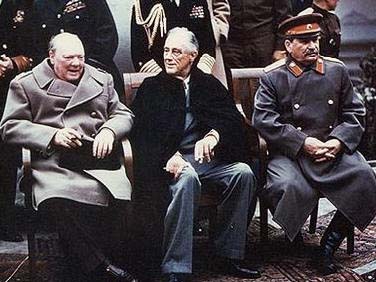 In the last days of the war, Hitler's second in command, Reichsführer-SS Heinrich Himmler, had been plotting behind Hitler's back in an attempt to negotiate a peace with America and Great Britain, with the aim of forming an alliance to fight against the Communists. He knew that half of Germany and all of Eastern Europe, with a population of 120 million people, had been promised to the Communists by American president Franklin D. Roosevelt at the Yalta Conference. As the leader who was in charge of all the concentration camps (his rank in the SS was equivalent to a 5-star General in the US Army), he planned to use the Jewish prisoners as bargaining chips in his negotiations with the non-Communist Allies. Himmler was determined to do all he could to hamper the inevitable take-over of Europe by the Communists. To this end, beginning on April 5, 1945, he ordered the execution of Communist leaders being held at the three main concentration camps in Germany: Dachau, Sachsenhausen and Buchenwald. Before surrendering Bergen-Belsen to the British on April 15, 1945, Himmler ordered about 7,000 people to be evacuated from the camp. The three train loads of prisoners, which left the camp between April 6 and April 11, were made up of prominent Dutch Jews, Hungarian Jews, Jewish prisoners from neutral countries and Jewish prisoners who held foreign passports. Himmler was hoping to use these prisoners to negotiate with the Allies. The rest of the prisoners at Bergen-Belsen were to be voluntarily turned over to the British. 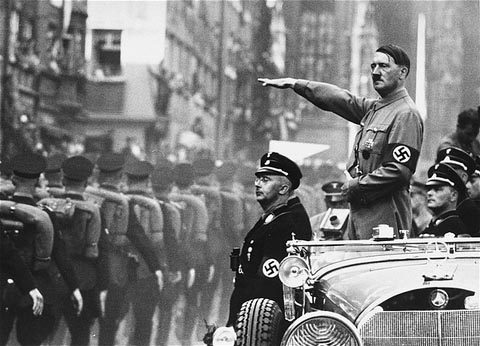 On April 4, 1945, American soldiers had seen their first Nazi horror camp in Germany, the abandoned forced labor camp at Ohrdruf, a sub-camp of Buchenwald. On April 11, American troops had discovered Buchenwald, which had already been taken over by the Communist political prisoners there. The next day, on April 12, 1945, Franklin D. Roosevelt died and Himmler had renewed hopes of negotiating a surrender to the Americans and the British, but not to the Communist Soviet Union. It was within this context that Himmler began negotiations to voluntarily turn the Bergen-Belsen concentration camp over to the British in early April 1945. Two German officers were sent to a British outpost to explain that there were 9,000 sick prisoners in the camp and that there was no water after the electric pump had been hit in an Allied bombing attack. The Germans proposed that the British Army should occupy the camp immediately to keep the epidemics in the camp from spreading to the troops on both sides. In return, the Germans offered to surrender the bridges over the river Aller. At first, the British rejected the German proposals, saying it was necessary that the British should occupy an area of ten kilometers around the camp in order to be sure of keeping their troops away from the epidemic, but eventually a compromise was reached and the British agreed. On April 15, 1945, Bergen-Belsen was surrendered to British Officer Derrick Sington, who wrote about it in a small book called "Belsen Uncovered" which was published by Duckworth, London in 1946. 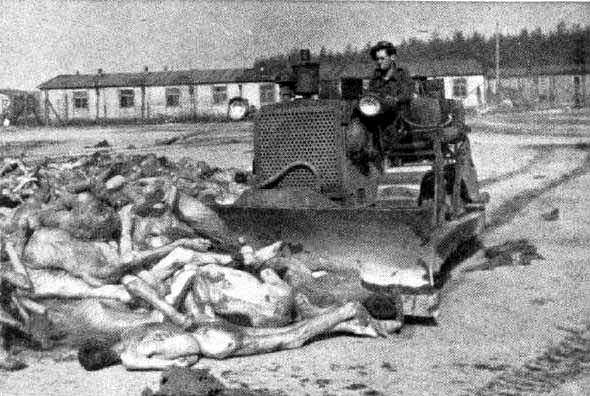 Himmler had not anticipated that the British would film the mounds of dead bodies in the camp and that the film would be shown in movie theaters around the world as proof of the Nazi Crimes against Humanity. Anyone who has ever seen the British film of the liberation of Bergen-Belsen will never forget the sight of British bulldozers shoving thousands of emaciated corpses into mass graves. Or the sight of the living dead, the emaciated prisoners whose bodies were nothing but skin and bones. As a result of the British Army taking control, Bergen-Belsen became the first Nazi horror camp to become widely known to the American public. After the British revealed the Nazi atrocities to the world, this camp came to epitomize the brutality and depravity of the Nazis who called the German people the Master Race (Herrenvolk) and who were carrying out a systematic plan to kill the Jews and others whom they considered sub-human (Untermenschen). Thanks to the British Army, which filmed the unbelievable sights that greeted them when they entered the camp, a grim record of the atrocities exists to this day. Anne Frank, the most famous victim of the Holocaust, lies in an unmarked mass grave at Bergen-Belsen, the date of her death unknown. Both Anne and her sister Margot died in the camp during one of the world's largest epidemics of typhus, a disease which is spread by body lice. The Journal of the American Medical Association wrote about the epidemic in a 1945 issue: By negotiations between British and German officers, British troops took over from the SS and the Wehrmacht the task of guarding the vast concentration camp at Belsen, a few miles northwest of Celle, which contains 60,000 prisoners, many of them political. This has been done because typhus is rampant in the camp and it is vital that no prisoners be released until the infection is checked. The advancing British agreed to refrain from bombing or shelling the area of the camp, and the Germans agreed to leave behind an armed guard which would be allowed to return to their own lines a week after the British arrival. General Dwight D. Eisenhower anticipated that future generations might find it hard to believe the horror that they found when Nazi Germany was liberated by the Allies. He ordered that both the Ohrdruf camp and the Buchenwald camp be preserved for several weeks in the state in which they were found and German civilians in nearby towns were forced to visit the camps to view the piles of rotting bodies. American soldiers, newspaper reporters and Congressmen were also called in as witnesses to the Nazi atrocities. But it was the British who had the biggest impact on the public conscience when they released their newsreel film of Bergen-Belsen to movie theaters around the world in the last days of the war. This was something that Himmler had not anticipated when he negotiated with the British to voluntarily turn the camp over to them. And he certainly didn't expect that the staff members, who had voluntarily stayed behind in the camp, would be arrested, or that some of the Hungarian soldiers, who were assigned to help with the surrender of the camp, would be shot by the British. As early as June 1942, there had been stories circulated by British radio about the Nazi death camps and Jews being killed in gas chambers, but few people in America believed it. The death camps in Poland had been discovered by the Soviets, starting on July 23, 1944, when the Majdanek camp just outside Lublin was liberated. On January 27, 1945, a day that is now commemorated as National Remembrance Day in Europe, the largest Nazi death camp at Auschwitz-Birkenau had been discovered by the Soviet army. These stories had been reported in the press, but Americans were still unaware of just how horrifying the Nazi camps actually were. When the film of Bergen-Belsen was shown in American theaters, it was naturally assumed that the prisoners had been deliberately starved to death or killed in a gas chamber, since the film made no mention of the typhus epidemic in the camp. Nor was it mentioned that the water pump at Bergen-Belsen had been hit by Allied bombs and fresh water had to be brought in by trucks. When British soldiers were finally allowed, as agreed upon in the negotiations, to enter Bergen-Belsen on April 15, 1945, they at first saw nothing amiss. Smiling, healthy prisoners came out to greet them and some of the 500 children in the camp cheered and waved to them. But as they advanced further into the camp, they were stunned by the sight of over 10,000 unburied naked bodies. The horror was beyond human imagination. The sickening stench of the rotting corpses was so great that British soldiers later claimed that they could smell the camp from a distance of 10 miles. In the last months of the war, as the Russian army advanced westward, prisoners in the camps in Poland had been evacuated and ultimately 60,000 prisoners had been crowded into the Bergen-Belsen camp which did not have enough space for them. Some of those who were still alive at Bergen-Belsen were walking skeletons. There were a variety of diseases that were rampant in the camp. The Germans claimed that they had been unable to fix the broken water pump which had been destroyed by Allied bombs, and many inmates were dying of thirst, even though the camp was near a creek which the camp Commandant claimed was not fit for drinking. The camp used cisterns for its water supply, but the water could not be accessed without the electric pump that had been hit in a bombing raid. The British promptly fixed the broken pump and provided water from the creek for the camp which had been without water for six days. The nearby Army garrison had arranged for drinking water to be brought to the camp by truck, but it was not nearly enough. Some of the female German guards, who had only arrived in the camp a couple of weeks before the liberation, appeared to be overweight, while many of the surviving prisoners appeared to be starving. The German Army garrison had facilities for baking 60,000 loaves of bread daily, but they had been providing only 10,000 loaves per day to the concentration camp, while keeping the rest to feed the German soldiers. The Camp Commandant had to scrounge for food in the countryside which was in the middle of a war zone. According to the British, the camp had been without food for six days, and there were no medical supplies at all. 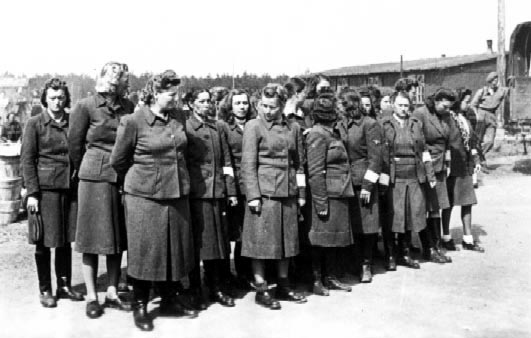 The concept of putting civilians into concentration camps in wartime was made famous by the British in the Boer War at the turn of the century, but it was the Nazis who had taken the idea to the extreme and had incarcerated millions in camps where they were deliberately starved and worked to death under inhuman conditions during World War II. Although 20,000 women and children had died of disease and starvation in the concentration camp run by the British in South Africa, this was nothing compared to the Bergen-Belsen camp where up to 600 people were dying each day from hunger and sickness during the final chaotic days of the World War II. The condition of the prisoners at Bergen-Belsen was so bad that many of them could not be kept alive even with the best of medical care given to them by the British Army. Approximately 13,000 of the Bergen-Belsen inmates died after the camp was liberated, in spite of the heroic efforts of the British to save them. The typhus epidemic was raging out of control in the camp, and the British were forced to move all the inmates to the nearby German Army garrison and then burn down the wooden barracks in the camp. Because typhus is transmitted by lice, burning down the barracks was the fastest way to stop the epidemic. 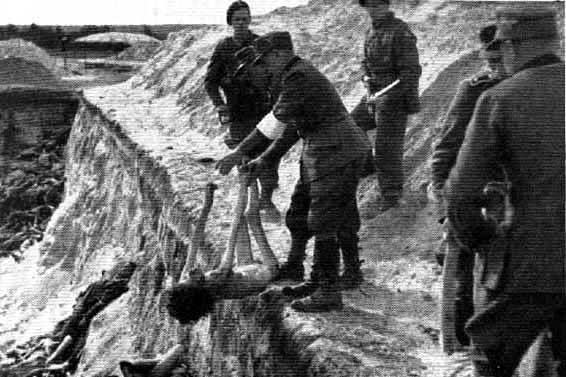 In the days just before the British arrived to take over, the German guards had ordered 2,000 prisoners in the camp to drag the dead bodies to mass graves, using strips of leather or cloth tied to the ankles of the corpses. After the British took control, the German guards were forced to handle the diseased bodies with their bare hands, without protective gloves, and 20 of the 80 guards became sick and died as a result. In the film that was shown in American theaters, the British narrator explained that this was done as punishment for the guards. The British soldiers would not touch the decomposing bodies; instead, they used bulldozers to shove the emaciated corpses into the mass graves. Many of the viewers who saw the British film mistakenly thought that it was heartless German soldiers who were driving the bulldozers. Leslie Hardman, a Jewish Chaplain with the British troops, wrote a book entitled "The Survivors - the story of the Belsen remnant" (Vallentine, Mitchell & Co. Ltd). He said that he was concerned after watching the bodies being shoved into the mass graves with a bulldozer. He asked the officer in charge if the dead could be treated with more dignity, but was told that the burial was urgent. The officer promised that he would call the Chaplain back to recite prayers when the grave was ready to be filled. After the liberation of the camp, German civilians from the nearby towns were forced to remove the bodies of the 13,000 prisoners who died afterwards, while the survivors stood by and jeered at them. The photograph below shows a group of survivors in the background on the left, watching as German citizens are forced to handle the diseased bodies with their bare hands at gunpoint. German homes in the nearby towns were taken by the British military and assigned to the surviving prisoners after the barracks in the camp were burned down. 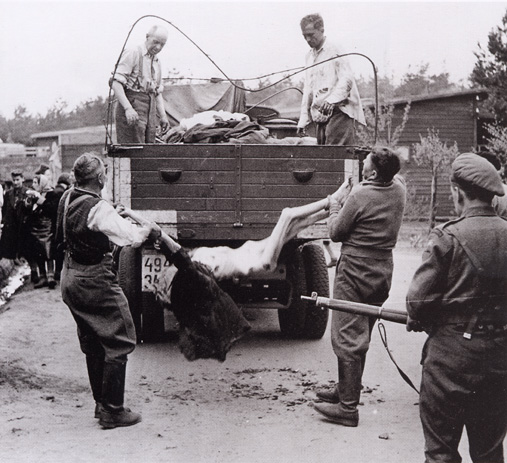 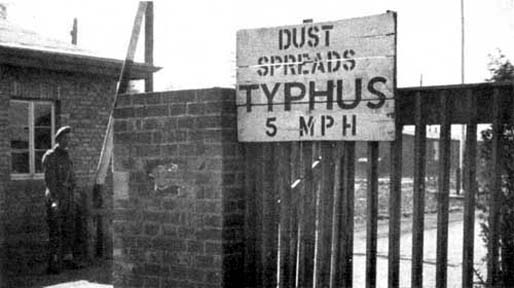 On May 4, 1945, part of the German Army surrendered to the British on the Lüneberg heath where the Bergen-Belsen camp is located. A few days later, on May 7th, the rest of the German Army surrendered to General Eisenhower. Eisenhower had been so sickened by the sight of dead bodies on his personal visit to the Ohrdruf forced labor camp near his field headquarters at Gotha, that he stunned the Germans by refusing the traditional handshake after the signing of an unconditional surrender by the German Army on May 7, 1945. World War II in Europe officially ended the next day on May 8, 1945. Thanks to the foresight of Eisenhower, who ordered that every American soldier stationed in Germany should visit the gas chamber at Dachau, today there is scarcely a person in America who has not heard the stories of the Nazi atrocities first-hand from a relative or an acquaintance. However, it was the British who, by bringing their soldiers to Bergen-Belsen to see the ultimate horror so that they could pass their eye-witness information on to future generations, insured that the world now knows the true extent of what happened at Bergen-Belsen. The film made by the British at Bergen-Belsen has been shown to students in America for over 50 years, so that the nightmare lives on. Bergen-Belsen is a name that has become synonymous with Man's Inhumanity to Man. Eight Separate Camps at BelsenBack to Bergen-Belsen indexHomeThis page was last updated on Juy 21, 2009 |